
Scroll Down To Order
Scroll Down To Order
A flicker of hope
is all that stood
. . . against barbarism.
Another outbreak of such a crisis of madness
[meaning the First World War]
would necessarily involve the destruction of
society in the public order. June 1, 1933
People cried out
for a better future.
Germany neither intends nor wishes
to interfere in the internal affairs
of Austria or to conclude an Anschluss. May 1935
If the problem is solved,
there will be no further territorial damands
in Europe by Germany. Sep 1938
CASTLES OF THE MIND ... VENTURE ACROSS ALL BRIDGES
The World War II Railroads in America

Learn about American trains in the 1940s
There are many books that regard the "Golden Age" of railroading as the early 20th Century when the so-called ‘Roarin’ Twenties were a great economic boon where the nation's wealth doubled between 1920-1929, and train travel in terms of rail mileage and also passenger miles hit a peak, yet, the writing was on the wall, and the automobiles and airplanes eroded the railroad industry’s dominance.
The Great Depression of the 1930s screwed everybody economically until 1940 or so but then WW II intervened. Let us begin with 4 educational videos.
The first begins to describe passenger service in b-w. The Baltimore and Ohio streamliner if seen in color would have been in gray and blue, a shade darker than royal blue, with gold lettering and pinstripes; runs 10 mins. Traveling by passenger train in the early forties was high. Many new locomotives, especially on the passenger systems, ran trains draped in the Art Deco style and were colorful--which never shows in black and white pictures. One must also remember this: this was the era called the streamline and the jitterbug era.
Ten minutes on the 400 streamliner in 1939 across the Midwest.
Next is a 27 min video linking us to lots of past history. This video by ALCO and General Electric was produced in color and was completed a couple of months before Pearl Harbor was bombed. Some locomotives that ran on steam were covered or shrouded in a metal covering to make them “streamlined.” This video shows them. Many later lost their shrouding due to the metal shortages of the era. Note the various locomotives in different styles and paint schemes in color. Topics include: Steel manufacturing. Troop trains. Carrying livestock. Specialized rolling stock. Car floats. Coal handling. Classification yards. Maintenance: track and right-of-way. Some of the most interesting parts are at the 1min35 sec, 7min43 sec, 11min57 sec, 16min 39 sec and the 20 minute 11 sec marks. There is something new said the narrator.

America in 1941 had 1,732,673 freight train cars in service that moved 19 million tons of freight on it’s 240,000 mile railroad system. America had over one million well-seasoned railroaders in WW II. Their task was difficult, handling the NE corridor, the West Coast corridor, port staging areas, top-secret cargo, myriad explosive munition trains, intercontinental long-distance trains, troop trains, replacement depots and not to mention the task of keeping everything running. When WW II ended in 1945, the number of RR employees was approximately 1,400,000, about two-thirds what it had been in the early 1920s but the American railroads carried more freight and passengers than anything statistically established in the nineteen-twenties.
In the so-called Golden Age of railroads, there were, for example, 2,408,967 freight train cars in 1926. When the national defense program was getting under way, some 15 years later, the railroads carried 405,840,000,000 ton-miles of freight with only 1,773,735 freight train cars. The majority of movement called for RR transport. U-boat sinkings and the suspension of freight traffic through the Panama Canal was a major reason the volume of freight handled by railroads in 1942 was one and one-half times that moved in World War One. In addition to moving people, in the first 12 months, some 10,000,000 tons of cargo were moved to their ports. The pressure of wartime operations was but only beginning.
In reality it was a slow process, hitting hard by mid-1943.
From time to time, there were temporary shortages of certain types of equipment, yet the roads did a free interchange of rolling stock between carriers. Also, they instituted specific distribution centers, totally disregarded advertising departments, increased women in the workforce, and created a special harmony between the Army Transportation Corps and the Association of American Railroads when they established the Association’s Military Transportation Section in the newly built Pentagon. On July 31, 1942, the U.S. Army Transportation Corps was established by President Roosevelt. With less cars, at the peak of the war, they carried 785,100,000,000 ton-miles, a jump of 93.6%.

Even more remarkable than the use in freight, was the increase in passenger rail traffic
In 1940, the railroads ran 23.8 billion passenger-miles with 88,308 passenger cars in service. [For comparisons sake, the railroads ran in the two peak years of 1927 and 1923: 88.79 billion passenger-miles and 88.29 billion passenger-miles respectively. The yearly number of passenger cars for all railroads as a reference point was around 57,451 in the 1920s; that figure sited is from 1924. [Incidentally, railroading in the 1920s was pretty dangerous, for ex. RR accidents and fatalities in 1923 saw 2,026 employees killed and 148 passengers killed. In the war years: (1941) 807 employees and 48 passengers were killed; (1942) 1,005 and 122 killed; (1943) 1,072 and 278; (1944) 1,087 and 287; (1945) 972 and 156.] By 1944, civilian passenger-miles were 95.6 billion--compare that to 2.6 billion domestic and overseas passenger-miles in 1945 by air. The photograph below was taken by WW II veteran Abe Nungesser at Camp Stoneman, located in Pittsburg, California.

Greatest passenger traffic in WW II
The two greatest totals of wartime passenger traffic were in 1943 and 1944, when 887,674 passengers rode the trains in 1943 and when 915,817 passengers rode the rails in 1944. Source: Statistical Abstract of the United States per thousand. Those numbers will never be equaled. Pullman transported 125 million passengers which if you know that the pop. of America was around 131 million, Pullman's wartime traffic was nearly equivalent to carrying every man, woman and child in the U.S.
For the record, Amtrak in 2024 carried 32.8 million passengers and 6.54 billion passenger- miles (all-time record.)
Millions of troops had to be assembled and moved. And, as stated like in a human body, arteries were important.
You had to have smooth flowing arteries.
How smooth it went is nurtured by the fact the numbers reached astronomical figures. In 1944, the passenger-miles hit tilt.
In 1944, with 88,217 passenger cars (13,175 were air- conditioned) in terms of traffic, passenger trains both streamliners and steam trains were running the unheard of total giving 95,575,196,000 passenger-miles, a rise of 302% since 1940.
The rationing of gas and tires plus the scarcity of replacement parts for the public was a main reason people had no choice but to flock to the trains, however, had the people who worked on the railroads not done their part, you would have never witnessed that 302%!
People from all walks of life went to work for the railroads, some with no experience in the railroad industry; women even worked in track maintenance. Women as train conductors was still not in style however, there were women on the yards as engineers and brakemen. Several passenger trains had stewardesses who helped in many ways and if called for acted as nurses. Those employed as stewardesses on sleek streamliners were luckiest (below).

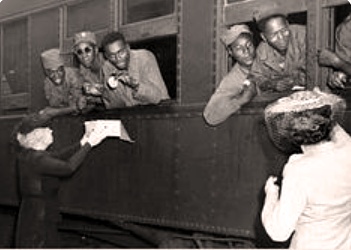


The three ladies are women Marines, Native Americans we might add.
One military division was composed of anywhere between 12,000 to 16,000 troops. To move one single armored division, with all its tanks, jeeps, armored cars, supply trucks and equipment, took 75 trains. For one full sized infantry div. 65 trains. Below is a color shot of women at the railroad working on a steam engine who took their job seriously. About 125,000 women worked on the railroads. Railroads were the backbone of troop movements. Below is a typical war scene of people in a crowded train station. Railroads facilitated the transport of 97% of all troops to military bases and ports of embarkation.


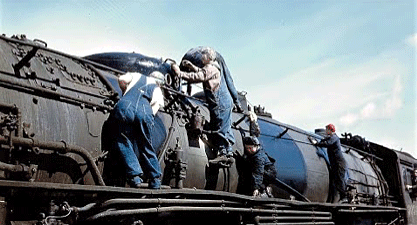

Millions of soldiers, sailors, and aviators had to criss cross vast expanse of land to get to their POE or training camps, and less we forget, that meant sheer distances often across cattle country and the wide open plains beyond Chicago. The Texas plains. The Rocky Mountains. The Dakotas; Cheyenne; Utah; New Mexico; Arizona. In color, cowboy country. In color, a streamliner in Miami, The Champion.





Between August of ’44 and Feb. of ’45, 36 divisions were sent to Europe. Brand new divisions, including 9 armored. Europe was stuffed with Americans. Allied units would be fighting some seventy German divisions on the Western Front. They were all part of Eisenhower’s troops. On January, 8, 1945, Gen. Ike commanded one Polish division, 3 Canadian divisions, 8 French, twelve British and fifty American divisions! That is a lot of troops. [We are not including the Pacific.]
Between that Aug. and Feb., the men and women of the above 36 divisions utilized 126 troop ships, with their organizational equipment sufficient to fill 266 Liberty ships.


One of the early problems in WW II was the bad condition of unboxed equipment and foods that were shipped. A good article to read is the author’s description of the Philippines; see menu 1942. Processing plants were established by the ports of embarkation to handle the unboxed and mismanaged crates, many had crevices which needed to be sealed, prior to items reaching the POE.
The San Francisco Port of Embarkation was the first to establish a processing plant, at Emeryville, California. By 1944, it got so huge it had to expand into Oakland.
Thirteen miles west of downtown Chicago, there was a staging yard that did wonders. This metropolis is in the Midwest, a railroad terminus and was a center hub of the country between East and West. Chicago once had the biggest and busiest railroad yard in the world. Initially opened in 1927 called the Provisio Yard, it handled 15,000 freight cars daily and was monstrous yet had it faltered, Hitler would have smiled, but he did not because the performance of the railroad worker did not falter.
In blue is a postcard representing a real streamliner The Crusader in color.


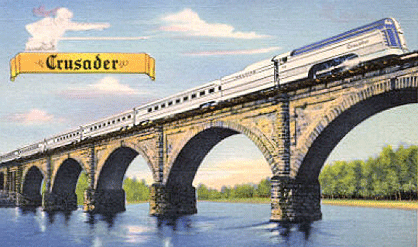
American passenger streamliners
The American passenger streamliners were the cream of the crop! [edit. note: Before Hitler’s Germany was being bombarded by air, or all of Europe for that matter, before war had begun for us—with the close exception of the Orient Express—no passenger train in all of Europe rivaled America’s streamliners. Not any train from Great Britain, not from Germany, no one! For a short while in the late 1930s, the ten fastest trains in the world were all American streamliners.] Streamliners? you ask. A million pages could be devoted on that topic. PBS America once had a nice 2 min educational clip with sound and everything on America's streamliners but they got cheap and recently took it out and replaced it with an article. This fine written article goes back to 2001 and is interesting on streamliners, also from PBS.
A by-gone era of the alpha and omega of steam streamliners, had some of the fanciest and most unusual designs that ever graced a locomotive’s body. The streamlined age for railroads actually began in 1934, when two trains were exhibited at the A Century of Progress World's Fair in Chicago, Illinois, the silvery fluted stainless steel Burlington Zephyr and the Union Pacific with a distinctive nose, The Streamliner, renamed later M-10000. The following year, Great Britain debuted it's streamliner the Silver Jubilee. Three years before, Germany had constructed its first streamliner with a curious name the Flying Hamburger, with only 98 seats. A German streamlined railcar set a speed record at 143 mph, between Berlin and Hamburg. The WW II generation grew-up with all this. By the time of 1939, Britain had two famous streamlined trains, and the United States more than you can count on one hand. The fastest speed test for a steam loco with a machine that measured the speed, a dynamometer, was in 1938 at 126 mph by a British Mallard streamlined steam engine. The guy in the mustache is noted designer Raymond Loewy. Streamliners over long distances did their share for defense, but not all were long-distance streamliners. Most usually operated on reservation-in-advance mode and some like the Capitol Limited provided special services to the public. A streamliner the Super Chief ran between Los Angeles and Chicago and was frequented by movie stars and important personalities. An average GI Joe would be extremely lucky to get a ticket on the Super Chief. It was an all-Pullman with a high class diner. A streamlined Electro-Motive's E1 diesel, inaugural run 1937, was expanded to twice weekly in 1938, and daily high-speed transcontinental service in 1948. A trio of boxcar engines, not pictured, 1A, 1B and 1C did a record in 36 hrs, 20 mins Chicago-Los Angeles run. By the time the Second World War erupted in 1939, while the majority of leading European nations were spending the bulk of their money on war armaments, the United States was not, and that is a key concept most of the world tends to forget. The U.S. by 1939, had between 49 to 90 streamliner passenger trains, in both steam and diesel power, depending on whom you talk to and that is where a lot of the capital expenditures went in America, not on the development of navies or planes or tanks. America had streamlined trains with every conceivable name you can think of, from the Hiawathas, Flying Yankees to Abraham Lincoln, Silver Meteors, Capitol Limited, Twentieth Century Limited, Green Diamond, Rocky Mountain Rockets, the Super Chief, the Ann Rutledge and the dynamic Mercury. Of course, that made Adolf Hitler smile with glee. The U.S. was not potent in war. Below is a photo of the premier train the Super Chief in its distinctive red warbonnet being readied for a run. Below it are 4 locomotives from the Pennsylvania RR.




The following link tells stories of wartime travel, with a sample of a gas ration sticker, centering on the station at San Luis Obispo, California. The train staton was jamming. The streamliner Coast Daylight (above the video, below) made a stop at this station. After a few years of running between Los Angeles and San Francisco, California, the Coast Daylight was so popular 51 new streamlined cars were added in 1940 so that you had a Morning Daylight, a Noon Daylight (suspended temporarily during the war) that also ran up the coast plus one that ran in the interior of California called the San Joaquin Daylights. An all-night-Pullman called the Lark also ran up the coast. A southbound Daylight in San Francisco and a northbound train in Los Angeles would leave at the same time; both departed at 8:15 am and arrive at 6 pm. They would pass each other in the neighborhood of San Luis Obispo. The deluxe Coast Daylights had the highest ridership numbers in the entire country. The connecting words were high speed and comfort, sort of what is occurring in California in 2025 with something called California High-Speed Rail between Los Angeles and San Francisco however, that has been under contract for many years, featuring a lousy cost run ballooning from $33 billion then $89 billion to $128 billion—when it will ever be completed to zombie city, as S.F is now known, is up for grabs; there is a more exciting building between Southern California to Las Vegas called Brightline West which will connect travelers along the 218-mile stretch, a large project that will be completed before the northern project, and a project that is the first dedicated high-speed corridor outside the famous Northeast Corridor (which supports the fanciest and most avante-garde engines called the NextGen Acelas which pull all-USB streamlined and comfortable coaches. But, let's get back to World War II.
Pullmans (the cars with beds ie. sleepers), coaches, club-cars, and diners were always unimaginably crowded while the shiny streamlined trains were available only on “reservation ticket” basis. An order was passed that eliminated all sleeping car service on routes of less than 450 miles. That hit travelers on corridors such as Chicago-Detroit, Chicago-Cleveland, New York-Boston, and New York-Washington D.C. Transcontinental long distance consists were the beneficiaries of sleepers. Old and newer equipment were taxed to the limit. If you're using an ancient iPad, go horizontal.
By 1944, the sweat and toil of the average American was paying off, and the goods and equipment that were assembled reached new towering heights but, the mountains of supplies—plus the millions of troops too—had to be assembled and moved. Did I mention that already? I guess I did. But, you still had to have smooth flowing arteries to function at your best.
The MRS, the U.S. Military Railway Service, handled all railroad troop movement overseas. During the Second World War, MRS operated and maintained railroads in Europe, North Africa, Iran, Asia, and the Pacific that totaled more than 22,000 miles, with over 43,500 GI-railroaders.
One favorite train during the war was the deluxe City of Miami from Chicago, especially in winter. The City of Miami would start in Chicago, as the Silver Meteor and Orange Blossom Special would come from NYC with connections from Boston, and they all headed down south to Florida. Trains would end in either Tampa Bay or Miami. The Orange Blossom Special was tricky, it was never a full streamlined train, and during WW II, you can imagine what coaches would be utilized, however, they were air-conditioned to handle the Florida humidity. You bet many naval officers trained and based in Florida used any of the above passenger trains. Took 9 weeks ground work and 9 weeks primary training then basic (2-3 months + at least 75 flying hours) before advanced pilot training. Four big Naval Air Stations for primary training were in Memphis TN, Norman OK, Corpus Christi, TX, Pensacola, FL. NAS is short for Naval Air Station. Corpus Christi by 1945 could handle 23,000 men and over 400 aircraft. U.S. Navy graduate pilots: 1942 10,869; 1943 20,842; 1944 21,067. Year-round warm weather were attractive features. Two photos below are Pensacola, Florida. Below them are engines in both the non-streamliner and streamliner, in the sleek Art Deco of the period.











The 1940s saw the new and the old. Electric and diesel ran beside old steam trains. A railroad vista included more diesels compared to the thirties alongside the old steam engines however, railroads were not allowed to build diesels until after the war because steel and other metal components were needed elsewhere in the Home Front. Speed was paramount and the advantage diesel engines had over steam was that they didn't need as many stops to obtain water or coal. Furthermore, what is not readily known is that the U.S. submarine fleet had priority on diesel power plants. In terms of diesel locomotives, the pulling power of diesels at that time was about 1,300 hp. The most powerful engines today have over 5,000 hp but normal is 3,000-4,500 hp each; string 4 or 5 engines together and you can pull 2-3 mile-long trains. A problem is creeping up, however, train freight corporations see no need to give ample notice to call in crews—some in as little as a 90 min advance notice or be disciplined— and the pressure of colossal RR mergers reduces safety today—they are asking for long trains to be manned by only 1 person, no more two.
The massive Big Boy from Union Pacific holds the record for the most hp in a steam engine: 6,290-7000 horsepower. American railroads mastered war traffic by utilizing every conceivable type of locomotive engine, from small 4-4-0 engines to gigantic piston-driven 85 foot masters of the rails. If you measured such a locomotive with her tender, a giganto would top 132 feet long (40.2 m).
A steam locomotive is basically composed of driver wheels which are the big sets of center wheels that could be as big as 63 inches in diameter. All steam engines are classified by their wheel configurations. When you see a 2-6-4 it means it has two pilot wheels in front of six driving wheels, followed by 4 more trailing wheels. A big engine could sport something like a 4-8-2 arrangement. Gigantos could be a 2-8-8-4 or 2-10-0 or 4-8-8-2, and that means the driver wheels are doubled. Such larger engines were built to traverse the steeper grades of a mountain with no mercy.




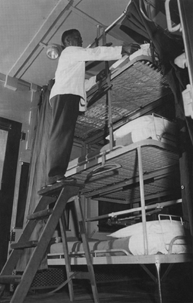
The Wounded Come Home
Japan had not lost a war in 2,600 years.
Nazi Germany still controlled much of Western Europe in April 1944.
Americans are too soft and diverse, so thought the Imperial Japanese. Japan had amassed over 180,000 prisoners, and most of them were still prisoners in early 1944. The Empire of Japan and Nazi Germany were still intact. Although Midway had proven victorious and many other islands had been wrested from the Japanese, although Hitler had lost a lot, they were still in control of many people.
There were many casualties, however, that were coming back home and the sights and sounds of them are hardly ever publicly told. It was pitiful and sad. Others, lay in the wings.
April of 1944, Axis leaders were under the impression people of the United States could not handle and much less mount any large-scale force and seize, capture, reinforce and hold pieces of real estate thousands of miles away much less enter the great domain of their homeland. But, the tide was to turn. Waiting for the gates to open, an enslaved peoples looked to the horizon. History beckoned a generation, the greatest generation, to come forth, and from those gates poured matter and men to illuminate a new dawn. The pitiful, the sad were there.
The new dawn with a new horizon was to be set upon.
The song Long Ago was a big hit in 1944, as sung by Rita Hayworth.
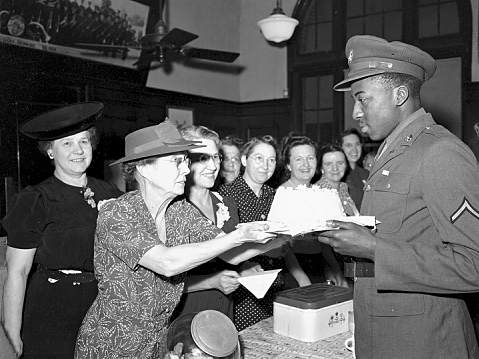





Your information is protected by
256-bit SSL encryption.